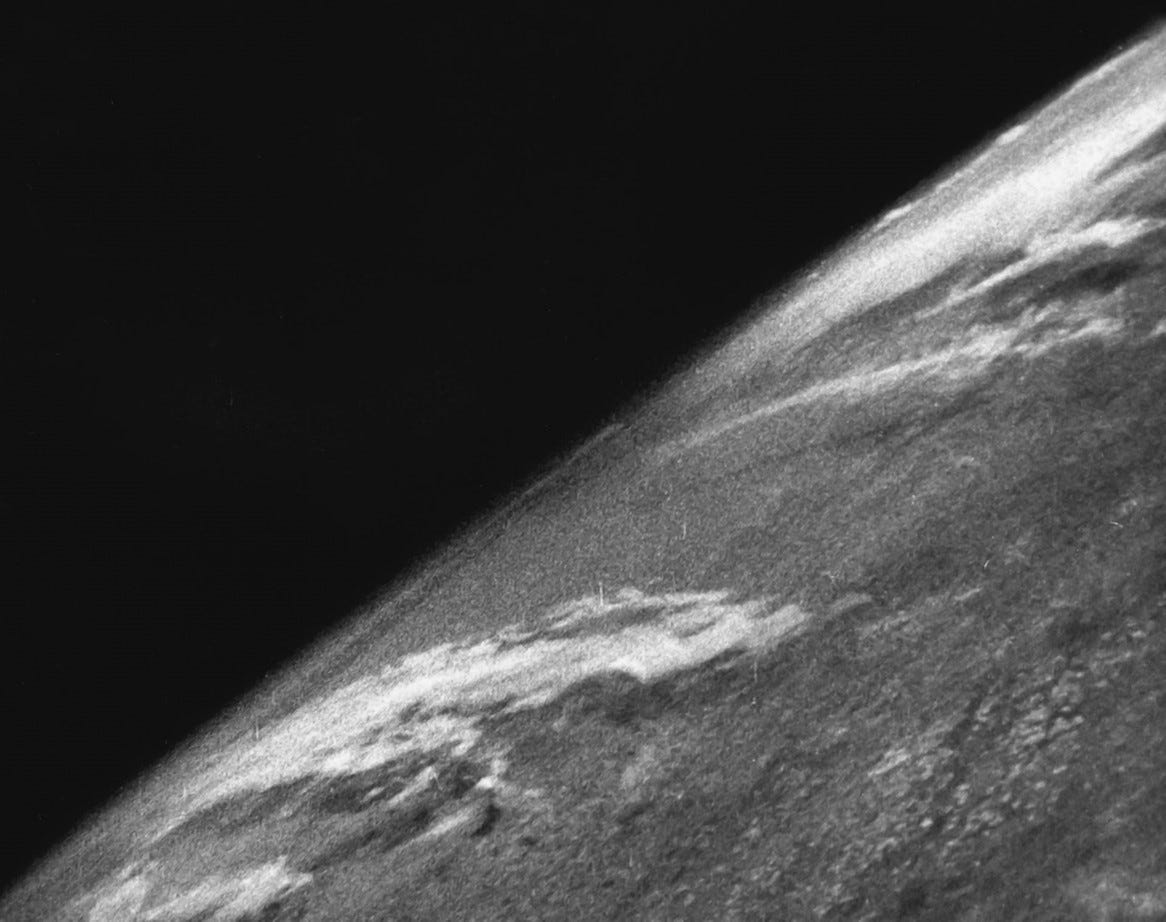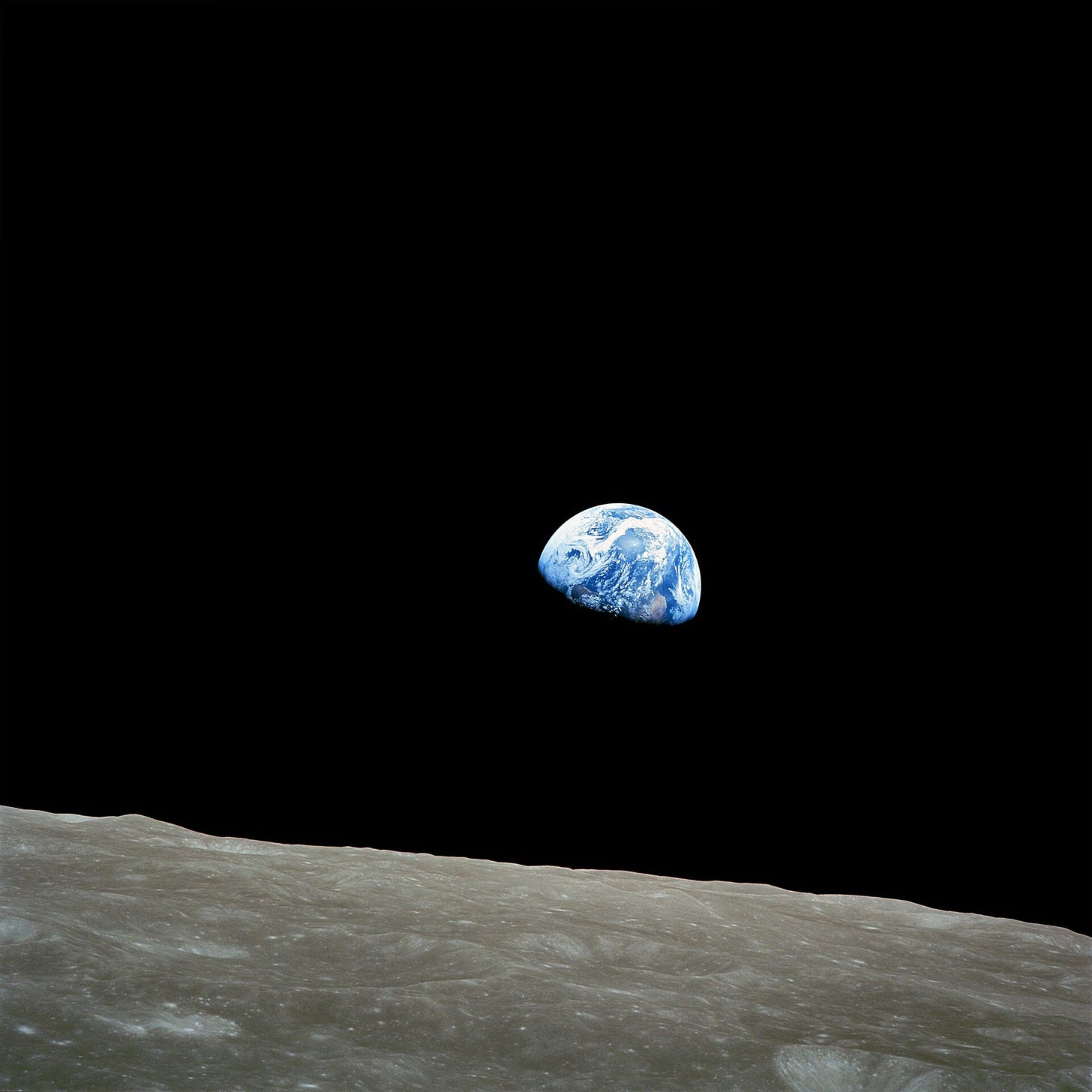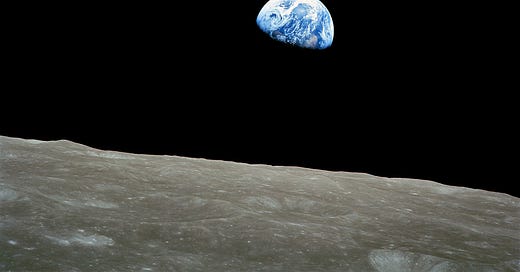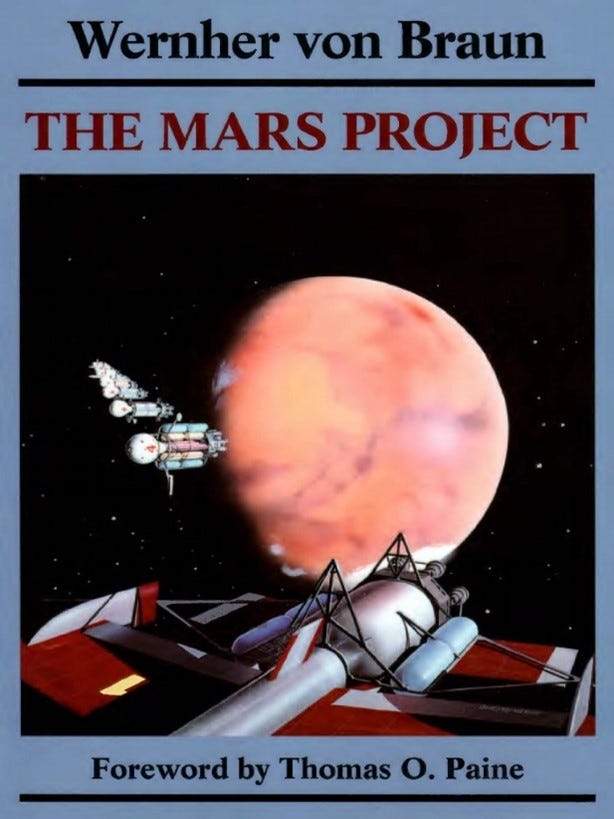A Photo from Space: A Captivating View of Our Fragile Planet
The Power of Earthrise: A Paradigm Shift
"The vast loneliness is awe-inspiring, and it makes you realize just what you have back there on Earth." Jim Lovell
Earth’s first photo from space
The first photograph of Earth from space is not the one you think it is. The first photograph of Earth from space was taken on October 24, 1946. (Reichhardt, 2006) It was captured using a 35mm film camera mounted on a V-2 missile launched from the White Sands Missile Range, the United States’ largest testing area and firing range located in the state of New Mexico.

The V-2 rocket [Vergeltungswaffe 2 (Vengeance Weapon 2)], a long-range guided ballistic missile, was developed in Nazi Germany between 1936 and 1942. It was designed by a team led by Wernher von Braun, an exceedingly brilliant scientist and astute manipulator who effectively used the Nazi regime to enable him to further his dream of space exploration. He didn’t succeed in accomplishing this in Nazi Germany, but in June 1945, the US State Department approved the transfer of Von Braun and his specialist team to the US. He worked on the US army’s ballistic missile programme and designed the rocket that launched the US’s first space satellite in 1958, four months after the USSR’s Sputnik sent the American political class into a panicky tailspin and marked the beginning of the Space Age. In 1960, his group was assimilated into NASA, where he became director of the new Marshall Space Flight Center and the lead architect of the Saturn V rocket that propelled the Apollo spacecraft to the moon.
Why am I telling the story of Wernher von Braun, you might ask. In 1949, while he was stationed in Fort Bliss in Texas, Wernher von Braun, wrote a highly technical science-fiction book, titled Marsprojekt. He failed to find a publisher at the time, but it was eventually translated into English and published in 2006 as Project Mars: A Technical Tale.
In Chapter 24, How Mars is Governed, there is the following passage:
“The Martian government was directed by ten men, the leader of whom was elected by universal suffrage for five years and entitled “Elan.” Two houses of Parliament enacted the laws to be administered by the Elon and his cabinet.”
Remind you of someone?
The U-2: A Stealthy Pioneer
In the 1950s, Lockheed's chief engineer, Clarence "Kelly" Johnson, led a team that designed an extraordinary aircraft called the U-2, also known as the "Dragon Lady." Its primary purpose was intelligence gathering, providing vital information about the Soviet Union, China, Vietnam, and Cuba, but it was also used in scientific research, satellite calibration, and for communication purposes.
The U-2 possessed remarkable capabilities, surpassing any other aircraft of its time. It could soar to altitudes of up to 70,000 feet, well beyond the reach of conventional planes. It was sent up to sample the bomb’s radioactive fallout before it fell, thus providing scientists with insights into both the weapons being tested and the circulation of the stratosphere. It was equipped with advanced high-altitude aerial reconnaissance cameras developed in the late 1950s (Powerful New Cameras for the U-2, n.d.) Nevertheless, the photographs taken by the U-2 cameras were classified (they had been declassified in 1995 by President Bill Clinton), and when they were available, they were grainy and black and white and, thus, provided limited information to scientists. Soon, this will change.
The Emergence of a Global Perspective
Before the space age, our environment was perceived as immediate and limited to our nearest surroundings. Concerns about the environment were primarily focused on maintaining the quality of our close surroundings. Climate change necessitated a shift in perspective—one that encompassed the entire globe. In the mid-1960s, atmospheric physicists and modellers started studying how the atmosphere would respond to elevated levels of carbon dioxide. Initially, the greenhouse effect was seen as a geophysical experiment, with carbon dioxide considered a changing parameter in the broader problem of atmospheric thermal equilibrium. (Hart & Victor, 1993).
During this period, scientists held diverse and competitive hypotheses, leading to disputes between those who advocated for warming theories and those who supported cooling theories. While the number of scientists considering the possibility of cooling was limited, these controversies and disputes posed significant challenges to decision-making and policy implementation. In 1968, a Time magazine essay titled "The Age of Effluence" highlighted the public's growing frustration and confusion, questioning which scientist to believe amidst increasing environmental degradation.
“What ever happened to America the Beautiful? While quite a bit of it is still visible, the recurring question reflects rising and spreading frustration over the nation's increasingly dirty air, filthy streets and malodorous rivers—the relentless degradations of an once virgin continent ……. It seems undeniable that some disaster may be lurking in all this, but laymen hardly know which scientist to believe”. (Age of Effluence, 1968)
As a result of these factors, a research programme that could monitor and investigate carbon dioxide and its effects on the atmosphere and temperature failed to emerge. Only a few scientists, despite their limited resources, persisted in their research on climate change, driven by their unwavering commitment to unravel the mysteries of our planet.
The space race between the United States and the Soviet Union served as a catalyst for groundbreaking advancements in space exploration. Following Yuri Gagarin's historic orbit mission aboard the Vostok 1 spacecraft in 1961, President John F. Kennedy announced a bold goal of sending an American safely to the Moon before the end of the decade. This ambitious objective gave birth to the Apollo project, the largest non-military technological endeavour ever undertaken by the United States.
The Apollo project had three primary goals: establishing technology to meet national interests in space, conducting scientific exploration of the Moon, and developing human capabilities to work in the lunar environment (Project Apollo: A Retrospective Analysis, n.d.). Kennedy's motivation was geopolitical, driven by the Soviet Union's advancements in space technology and its ability to put a satellite into orbit with the R-7 intercontinental ballistic missile. The launch of Sputnik in 1957 shocked Americans, who believed themselves to be at the forefront of technological progress. Kennedy emphasized the idea of a "missile gap" between the superpowers, fuelling fears of Soviet dominance. There was no such gap; the R-7 was never deployed operationally. America’s U-2 spy planes gave a strong indication of this. But it was too late to change the election results—and it could not be talked about anyway—because the satellites’ mere existence was beyond top secret.
Despite the initial fear and competition, the Apollo missions ultimately symbolized a triumph of human ingenuity and collaboration. On Christmas Eve 1968, Apollo 8 became the first manned mission to orbit the Moon. The crew, Commander Frank Borman, Command Module Pilot James Lovell, and Lunar Module Pilot William Anders, captured a series of iconic photographs of Earth. These images, showcasing the Earth and moon from a perspective never seen before, profoundly impacted humanity's perception of our planet.
Jim Lovell's words, " You can hide the Earth behind your thumb. Everything that you’ve ever known, your loved ones, your business, the problems of the Earth itself – all behind your thumb’, underscored the realisation that everything we hold dear is encompassed within this tiny sphere. (STAFF, 2007),

These pictures, especially Earthrise, one of the most famous and influential photographs ever taken, transformed people's attitudes toward our home planet. They realised how small and fragile their home planet is and offered a completely different perspective on the way they see the earth and its environment. This powerful image served as a catalyst, inspiring the environmental movement and fostering a collective responsibility for the preservation of our planet.
As Apollo 8 astronaut Bill Anders said, "We came all this way to explore the moon, and the most important thing is that we discovered the Earth''.
Sources and further reading
Age of Effluence. (1968, May 10). Time, p. 53.
Hart, D. M., & Victor, D. G. (1993, nOVEMBER). Scientific Elites and the Making of the U.S. Policy for Climate Change Research, 1957-74. Social Studies of Science,, 23(4), 643-80.
Powerful New Cameras for the U-2. (n.d.). Retrieved from National Museum of the United States Air Force : https://www.nationalmuseum.af.mil/Visit/Museum-Exhibits/Fact-Sheets/Display/Article/197566/powerful-new-cameras-for-the-u-2/
Project Apollo: A Retrospective Analysis. (n.d.). Retrieved from NASA History: (https://history.nasa.gov/Apollomon/Apollo.html)
Reichhardt, T. (2006, 10 24). Smithsonian Magazine. Retrieved 2023, from https://www.smithsonianmag.com/air-space-magazine/the-first-photo-from-space-13721411/
STAFF, N. (2007, 10 11). The Earth Behind a Man's Thumb. Newsweek, pp. https://www.newsweek.com/earth-behind-mans-thumb-96783.




